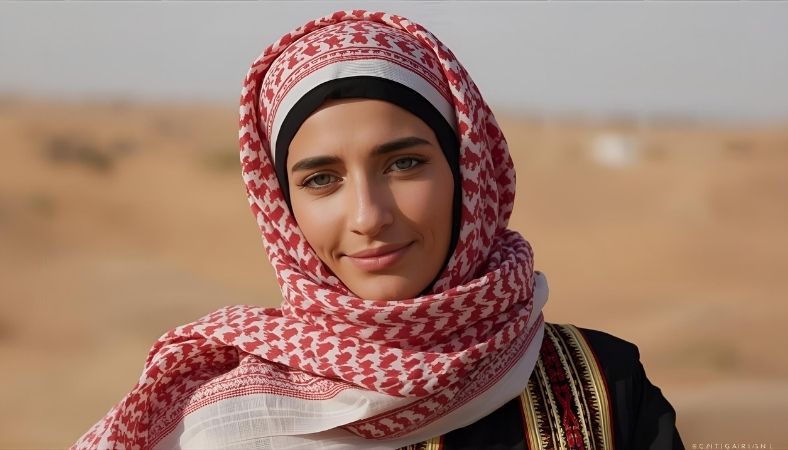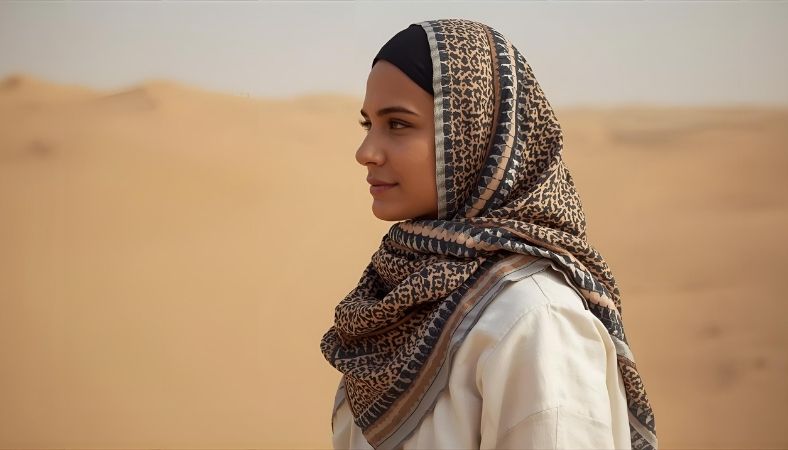Learn the simple differences between keffiyeh and shemagh scarves, their cultural roots in Middle Eastern headwear, and tips on wearing these desert scarves for style or protection. Find out how they fit into daily life and trends.
Hey there, friend. Have you ever seen those cool checkered scarves wrapped around heads in movies or on the street? Maybe you’ve wondered what they’re called or why people wear them. Well, that’s what we’re chatting about today – keffiyeh and shemagh. These aren’t just bits of cloth; they’re like old friends from the desert that keep you safe from sun and sand. Picture yourself in a hot, dusty place, and one of these scarves becomes your best buddy. Let’s talk about what makes them special, how they’re different, and why folks still love them now.
Key Takeaways
- Keffiyeh is a light black-and-white scarf from Palestine, symbol of pride.
- Shemagh is a thicker red-and-white one from Jordan or Gulf, good for tough weather.
- Both protect from sun and sand, but have unique cultural stories.
- They are trendy in 2025 fashion, like with thobes or protests.
- Wear them right to show respect and stay comfy.
What is a Keffiyeh?
A keffiyeh is a square scarf made from soft cotton. It’s often black and white with a checkered look, like a picnic blanket but way cooler. People in places like Palestine wrap it around their head or neck to stay safe from hot sun or blowing dust. It’s light, so it doesn’t feel heavy on a warm day. But sometimes, folks worry it might look too political, like picking a side in a big story.
This scarf helps in real ways. Imagine you’re out walking in bright light – it shades your eyes. Or if sand flies up, it covers your face. Yet, it can spark talks because of what it means to some groups. That’s part of its charm, though – it’s more than fabric.
Keffiyeh History
The keffiyeh started way back in old times, like in Mesopotamia, where folks needed something to block the sun while working fields. It was just a handy tool at first. Then, in the 1960s, a leader named Yasser Arafat wore it a lot, making it a sign of standing strong for Palestine. Now, it’s like a badge of who you are.
Fun fact: Back in history, about 90% of folks in Bethlehem were Christian under Arab rule, and they shared this scarf too. It shows how it’s for everyone in that land, not just one group. Over years, it turned from farm wear to something that says “I’m proud of my roots.”
Think of it like your favorite hat that reminds you of home. The keffiyeh has stuck around because it’s useful and tells a tale.
What is a Shemagh?
A shemagh is another square scarf, but this one often comes in red and white with little tassels on the edges. It’s made from a mix of cotton and wool, so it’s thicker and warmer. Folks in Jordan or the Gulf areas use it to fight off cold nights or strong winds in the desert. It’s sturdy, like a tough blanket you can wear.
This scarf is great for hard spots. If you’re camping and it gets chilly, wrap it tight. But it might feel too warm on super hot days. That’s the trade-off – extra protection means a bit more weight.
People love it for adventures. Say you’re hiking and need something quick to tie up gear – a shemagh works. It’s like a multi-tool in cloth form.
Shemagh History
The shemagh comes from Bedouin people who live in deserts. They needed something to cover up from sand storms and hot days. The tassels aren’t just for looks; bigger ones once showed if someone was important, like a leader.
In World War II, soldiers from places like Britain wore them to blend in and stay safe. It helped fight the heat while battling foes. Now, it’s a sign of bravery in Jordan, worn by royals and everyday folks.
It’s like a story passed down. Each fold holds a bit of the past, from nomads to now.
Key Differences
Keffiyeh and shemagh look alike at first, but they’re not the same. The keffiyeh has black-and-white checks, light for quick wraps. The shemagh goes red-and-white, thicker for rough spots. One comes from Palestine, the other from Jordan or nearby.
Take Yasser Arafat he made the keffiyeh famous for standing up. Jordan’s kings wear the shemagh to show their land’s spirit. That’s how they differ in tales.
Here’s a quick list:
- Color: Black-white for keffiyeh, red-white for shemagh.
- Weight: Light cotton vs thick blend.
- Symbol: Resistance for one, bravery for the other.
These bits make each unique. Pick based on what you need or like.
Cultural Meaning
The keffiyeh means pride for Palestinians. It’s like saying “This is me, and I’m strong.” Folks wear it to show they care about their home and fights for rights. In protests, it’s a common sight, linking people together.
The shemagh stands for Jordanian ways. It’s about heritage, like Bedouin life in deserts. Tassels tell of status, bigger for big shots. Both scarves root in Arabic words for “cover,” showing they’re shields with heart.
Experts say from old texts, they’re tied to land and folks. Like Wikipedia notes, colors link to places – black-white for one spot, red for another. Wearing them right honors that. If you mix it up without knowing, it might upset some. But learn the story, and it’s a nod to respect.
Picture a family gathering someone wraps a keffiyeh, sharing old yarns. That’s the real magic.
How to Wear Them
Wearing a keffiyeh is easy. Fold it into a big triangle, put the flat side on your forehead, and tie the ends at the back. Pull it over your nose if dust flies. It’s quick for on-the-go.
For shemagh, do the same but use a rope called agal to hold it. Twist it around your head like a crown. Keeps it from slipping in wind.
Tips: Use as a neck wrap for cold, or tie as a bag for small stuff. Great for picnics or trips. Compared to a plain ghutra, which is white and simple, these have patterns for extra style.
Try it step by step:
- Fold square to triangle.
- Place on head, point down back.
- Cross ends under chin, tie behind.
- Adjust for comfy fit.
Feels good once you get it. Practice in a mirror first.
Modern Uses and Trends
In 2025, these scarves are big in style. Keffiyeh shows up in fashion weeks, like Copenhagen, turned into skirts or bags. Folks on TikTok wrap them chic, mixing with jeans or dresses. It’s a nod to solidarity too, worn in walks for causes.
Shemagh pairs with thobes for Muslim men, layered for cool looks. New designs like CODIVA 2025 add fresh twists. Use them for hikes, as face covers, or street vibe.
Trend fact: Sales jumped 75% for keffiyeh after big news, showing folks want real pieces. Tip: Layer over a hoodie for winter warmth. Or as a belt for fun.
See celebs like singers wearing keffiyeh dresses for events. It’s blending old with new.
Buying and Care Tips
Buy from real makers, like Hirbawi in Palestine for keffiyeh – it’s the last factory there, helping locals. For shemagh, look for Jordanian weaves. Avoid cheap copies; they fall apart fast.
Care is simple: Wash in cool water, no hot dryer. Hang to dry so shape stays. Iron low if needed.
Compared to fakes, real ones last years. Stat: True ones support jobs, like in factories keeping traditions alive.
Pick cotton for breath, wool mix for warmth. Store folded, not bunched.
Frequently Asked Questions
What is the difference between keffiyeh and shemagh?
Keffiyeh is a lightweight, black-and-white checkered scarf mainly from Palestine, symbolizing cultural pride and resistance against challenges. It’s often cotton, easy to wrap for sun protection or as a neck scarf. Shemagh, on the other hand, is thicker, red-and-white with tassels, from Jordan or Gulf regions, representing bravery and Bedouin heritage. Both are square but differ in fabric weight – keffiyeh feels airy for hot days, while shemagh adds warmth for cooler nights. Patterns tell stories: fishnet for keffiyeh links to seas, tassels for shemagh show status. Choose based on your weather needs or what meaning speaks to you. In fashion, keffiyeh trends in protests, shemagh with thobes.
Is keffiyeh the same as shemagh?
No, they’re close but not twins. Keffiyeh focuses on Palestinian roots with its black-white checks, light cotton for quick wraps in Levant areas like Syria. It’s a symbol of identity, worn by leaders like Arafat to show strength. Shemagh is Gulf-style, red-white, often with wool for desert toughness in Jordan. Tassels add cultural flair, bigger ones for important folks. While both protect from elements, keffiyeh leans political, shemagh traditional. In 2025, keffiyeh mixes into dresses, shemagh layers with modern outfits. Respect origins – don’t confuse them. If buying, check real makers to honor the craft.
How do you wear a keffiyeh or shemagh?
Start by folding the square into a triangle. For keffiyeh, place flat edge on forehead, point down back, cross ends under chin, tie at neck. Adjust to cover nose if dusty. Shemagh follows similar: add agal rope on top for hold, twist ends around. Wear as head cover, neck warmer, or shoulder drape. Tips: Practice ties like pirate or bandit style for fun. In cold, layer over hat; in heat, loosen for air. Both work for camping – use as pillow or sling. Remember, wear with care to respect cultures. Try in mirror first for comfy fit. Modern twists include belt or bag.
What does keffiyeh symbolize?
Keffiyeh stands for Palestinian identity, resilience, and resistance. Its black-white pattern echoes trade routes, olive trees, and seas – fishnet for fishermen, leaves for strength. Popularized by Arafat in 1960s, it’s worn in solidarity worldwide, like protests or fashion. Not just cloth, it’s a story of pride against odds. In history, from ancient farms to now, it shields and unites. Avoid appropriation; learn its roots. In 2025, it trends as symbol in walks or style, showing support. Pair with respect for real meaning.
Can anyone wear a shemagh?
Yes, but do it thoughtfully. Shemagh roots in Jordanian and Bedouin culture, symbolizing bravery with red-white checks and tassels for status. It’s practical for deserts, military, or hikes – shields sun, sand, cold. Anyone can try for style or function, like wrapping in adventures. But know its heritage to avoid offense; it’s not just trend. In 2025, it pairs with thobes or casual wear. Buy authentic to support makers. If new, start simple ties. Shows respect when worn right.
Is keffiyeh religious?
No, it’s cultural, not tied to one faith. Keffiyeh comes from Middle East traditions for protection and identity, worn by Muslims, Christians, others in Palestine. Patterns link to land – olives, seas – more about heritage than religion. Used in daily life, protests, fashion. In history, shared across groups, like in Bethlehem. Wear for solidarity or style, but understand meaning. Not required by any belief, just a scarf with heart.
Final Takeaway
Try a keffiyeh or shemagh next time you need sun protection or want cool style pick one that fits your story!


